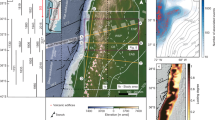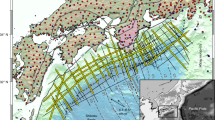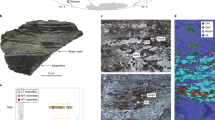Abstract
The variation of elastic-wave velocities as a function of the direction of propagation through the Earth’s interior is a widely documented phenomenon called seismic anisotropy. The geometry and amount of seismic anisotropy is generally estimated by measuring shear-wave splitting, which consists of determining the polarization direction of the fast shear-wave component and the time delay between the fast and slow, orthogonally polarized, waves. In subduction zones, the teleseismic fast shear-wave component is oriented generally parallel to the strike of the trench1, although a few exceptions have been reported (Cascadia2 and restricted areas of South America3,4). The interpretation of shear-wave splitting above subduction zones has been controversial and none of the inferred models seems to be sufficiently complete to explain the entire range of anisotropic patterns registered worldwide1. Here we show that the amount and the geometry of seismic anisotropies measured in the forearc regions of subduction zones strongly depend on the preferred orientation of hydrated faults in the subducting oceanic plate. The anisotropy originates from the crystallographic preferred orientation of highly anisotropic hydrous minerals (serpentine and talc) formed along steeply dipping faults and from the larger-scale vertical layering consisting of dry and hydrated crust–mantle sections whose spacing is several times smaller than teleseismic wavelengths. Fault orientations and estimated delay times are consistent with the observed shear-wave splitting patterns in most subduction zones.
This is a preview of subscription content, access via your institution
Access options
Subscribe to this journal
Receive 51 print issues and online access
$199.00 per year
only $3.90 per issue
Buy this article
- Purchase on Springer Link
- Instant access to full article PDF
Prices may be subject to local taxes which are calculated during checkout




Similar content being viewed by others
References
Long, M. D. & Silver, P. The subduction zone flow field from seismic anisotropy: a global view. Science 319, 315–318 (2008)
Currie, C. A., Cassidy, J. F., Hyndman, R. D. & Bostock, M. G. Shear wave anisotropy beneath the Cascadia subduction zone and western North American craton. Geophys. J. Int. 157, 341–353 (2004)
Russo, R. M. & Silver, P. G. Trench-parallel flow beneath the Nazca plate from seismic anisotropy. Science 263, 1105–1111 (1994)
Anderson, M. L., Zandt, G., Triep, E., Fouch, M. & Beck, S. Anisotropy and mantle flow in the Chile–Argentina subduction zone. Geophys. Res. Lett. 31 L23608 10.1029/2004GL020906 (2004)
Savage, M. K. Seismic anisotropy and mantle deformation: what have we learned from shear wave splitting? Rev. Geophys. 37, 65–106 (1999)
Park, J. & Levin, V. Seismic anisotropy: tracing plate dynamics in the mantle. Science 296, 485–489 (2002)
Nicolas, A. & Christensen, N. I. in Composition, Structure and Dynamics of the Lithosphere–Asthenosphere System (eds Fuchs, K. & Froidevaux, C.) 111–123 (Am. Geophys. Union, 1987)
Visser, K., Trampert, J., Lebedev, S. & Kennett, B. L. N. Probability of radial anisotropy in the deep mantle. Earth Planet. Sci. Lett. 270, 241–250 (2008)
Backus, G. E. Long-wave elastic anisotropy produced by horizontal layering. J. Geophys. Res. 67, 4427–4440 (1962)
Crampin, S. The fracture criticality of crustal rocks. Geophys. J. Int. 118, 428–438 (1994)
Kneller, E. A., van Keken, E., Karato, S. & Park, J. B-type olivine fabric in the mantle wedge: insight from high-resolution non-Newtonian subduction zone models. Earth Planet. Sci. Lett. 237, 781–797 (2005)
Matcham, I., Savage, M. K. & Gledhill, K. R. Distribution of seismic anisotropy in the subduction zone beneath the Wellington region, New Zealand. Geophys. J. Int. 140, 1–10 (2000)
Kincaid, C. & Griffiths, R. W. Laboratory models of the thermal evolution of the mantle during rollback subduction. Nature 425, 58–62 (2003)
Piromallo, C., Becker, T. W., Funiciello, F. & Faccenna, C. Three-dimensional instantaneous mantle flow induced by subduction. Geophys. Res. Lett. 33 L08304 10.1029/2005GL025390 (2006)
Masson, D. G. Fault patterns at outer trench walls. Mar. Geophys. Res. 13, 209–225 (1991)
Ranero, C. R., Villaseñor, A., Phipps Morgan, J. & Weinribe, W. Relationship between bend-faulting at trenches and intermediate-depth seismicity. Geochem. Geophys. Geosyst. 6 Q12002 10.1029/2005GC000997 (2005)
Ranero, C. R., Phipps Morgan, J. & Reichert, C. Bending-related faulting and mantle serpentinization at the Middle America trench. Nature 425, 367–373 (2003)
Peacock, S. M. Are the lower planes of double seismic zones caused by serpentine dehydration in subducting oceanic mantle? Geology 29, 299–302 (2001)
Omori, S., Komabayashi, T. & Maruyama, S. Dehydration and earthquakes in the subducting slab: empirical link in intermediate and deep seismic zones. Phys. Earth. Planet. Inter. 146, 297–311 (2004)
MacDonald, H. & Fyfe, W. S. Rate of serpentinization in seafloor environments. Tectonophysics 116, 123–135 (1985)
Jiao, W., Silver, P. G., Fei, Y. & Prewitt, T. Do intermediate- and deep-focus earthquakes occur on preexisting weak zones? An examination of Tonga subduction zone. J. Geophys. Res. 105, 28,125–28,138 (2000)
Brudzinski, M. R., Thurber, C. H., Hacker, B. R. & Engdahl, E. R. Global prevalence of double Benioff zones. Science 316, 1472–1474 (2007)
Grevemeyer, I., Ranero, C. R., Flueh, E. R., Klaeschen, D. & Bialas, J. Passive and active seismological study of bending-related faulting and mantle serpentinization at the Middle America trench. Earth Planet. Sci. Lett. 258, 528–542 (2007)
Gee, L. S. & Jordan, T. H. Polarization anisotropy and fine-scale structure of the Eurasian upper mantle. Geophys. Res. Lett. 15, 824–827 (1988)
Babuska, V., Plomerova, J., Vecsey, L., Granet, M. & Achauer, U. Seismic anisotropy of the French Massif and predisposition of Cenozoic rifting and volcanism by Variscan suture hidden in the mantle lithosphere. Tectonics 21 1029 10129/2001TC901035 (2002)
Norrel, G. T., Teixell, A. & Harper, G. D. Microstructure of serpentine mylonites from the Josephine ophiolites and serpentinization in retrogressive shear zones, California. Geol. Soc. Am. Bull. 101, 673–682 (1989)
Escartin, J., Hirth, G. & Evans, B. Nondilatant brittle deformation of serpentinites: implications for Mohr–Coulomb theory and the strength of faults. J. Geophys. Res. 102, 2897–2913 (1997)
Hirauchi, K. Serpentinite textural evolution related to tectonically controlled solid-state intrusion along the Kurosegawa Belt, northwestern Kanto Mountains, central Japan. I. Arc 15, 156–164 (2006)
Kirby, S., Engdahl, R. & Denlinger, R. Intermediate-depth intraslab earthquakes and arc volcanism as physical expression of crustal and uppermost mantle metamorphism in subducting slabs. Geophys. Monogr. 96, 195–214 (1996)
Chaytor, J. D. & Goldfinger, C. Dziak, R. P. & Fox, C. G. Active deformation of the Gorda plate: constraining deformation models with new geophysical data. Geology 32, 353–356 (2004)
Okaya, D. A. & Christensen, N. I. Anisotropic effects of non-axial seismic wave propagation in foliated crustal rocks. Geophys. Res. Lett. 29 1507 10.1029/2001GL014285 (2002)
Kneller, E. A., Long, M. D. & van Keken, P. E. Olivine fabric transition and shear wave anisotropy in the Ryukyu subduction system. Earth Planet. Sci. Lett. 268, 268–282 (2008)
Gerya, T. V. & Yuen, D. A. Robust characteristic method for modeling multiphase visco-elasto-plastic thermo-mechanical problems. Phys. Earth Planet. Inter. 163, 83–105 (2007)
Hall, C. E., Gurnis, M., Sdrolias, M., Lavier, L. L. & Muller, R. D. Catastrophic initiation of subduction following forced convergence across fractures zones. Earth Planet. Sci. Lett. 212, 15–30 (2003)
Gerya, T. V., Connolly, J. A. D. & Yuen, D. A. Why is terrestrial subduction one-sided? Geology 36, 43–46 (2008)
Turcotte, D. L. & Schubert, G. Geodynamics (Cambridge Univ. Press, 2002)
Ben Ismaïl, W. & Mainprice, D. A statistical view of the strength of seismic anisotropy in the upper mantle based on petrofabric studies of ophiolite and xenolith samples. Tectonophysics 296, 145–157 (1998)
Ben Ismaïl, W. & Mainprice, D. An assessment of the contribution of enstatite to the upper mantle seismic anisotropy. Tectonophysics (submitted)
Wada, I., Wang, K., He, J. & Hyndman, R. D. Weakening of the subduction interface and its effects on surface heat flow, slab dehydration, and mantle wedge serpentinization. J. Geophys. Res. 113 B04402 10.1029/2007JB005190 (2008)
Abramson, E. H., Brown, J. M., Slutsky, L. J. & Zaug, J. The elastic constants of San Carlos olivine to 17 GPa. J. Geophys. Res. 102, 12253–12263 (1997)
Isaak, D. G. High-temperature elasticity of iron-bearing olivine. J. Geophys. Res. 97, 1871–1885 (1992)
Chai, M., Brown, J. M. & Slutsky, L. J. The elastic constants of an aluminous orthopyroxene to 12.5 GPa. J. Geophys. Res. 102, 14779–14785 (1977)
Jackson, J. M., Sinogeikin, S. V. & Bass, J. D. Sound velocities and single-crystal elasticity of orthoenstatite to 1073K at ambient pressure. Phys. Earth Planet. Inter. 161, 1–12 (2007)
Pellenq, R. J.-M et al. Atomistic calculations of the elastic properties of antigorite at upper mantle conditions: application to the seismic properties in subduction zones. Earth Planet. Sci. Lett. (submitted)
Kern, H., Liu, B. & Popp, B. Relationship between anisotropy of P and S wave velocities and anisotropy of attenuation in serpentinite and amphibolite. J. Geophys. Res. 102, 3051–3065 (1997)
March, A. Mathematische Theorie der Regelung nach der Korngestalt bei affiner Deformation. Z. Kristallogr. 81, 285–297 (1932)
Paterson, S. R., Yu, H. & Oertel, G. Primary and tectonic fabric intensities in mudrocks. Tectonophysics 247, 105–119 (1995)
McLaughlin, R. A. A study of the differential scheme for composite materials. Int. J. Eng. Sci. 15, 237–244 (1977)
Mainprice, D. Modelling the anisotropic seismic properties of partially molten rocks found at Mid-Ocean. Tectonophysics 279, 161–179 (1997)
Christensen, N. I. Compressional wave velocities in possible mantle rocks to pressures of 30 kilobars. J. Geophys. Res. 79, 407–412 (1974)
Müller, C. Upper mantle seismic anisotropy beneath Antarctica and the Scotia Sea region. Geophys. J. Int. 147, 105–122 (2001)
Russo, R. M., Silver, P. G., Franke, M., Ambeh, W. B. & James, D. E. Shear-wave splitting in northeast Venezuela, Trinidad, and the eastern Caribbean. Phys. Earth Planet. Inter. 95, 251–275 (1996)
Müller, C., Bayer, B., Eckstaller, A. & Miller, H. Mantle flow in the South Sandwich subduction environment from source-side shear wave splitting. Geophys. Res. Lett. 35 L03301 10.1029/2007GL032411 (2008)
Chaytor, J. D., Goldfinger, C., Dziak, R. P. & Fox, C. G. Active deformation of the Gorda plate: constraining deformation models with new geophysical data. Geology 32, 353–356 (2004)
Deplus, C. et al. Direct evidence of active deformation in the eastern Indian oceanic plate. Geology 26, 131–134 (1998)
Lallemand, S. E. et al. Genetic relations between the central and southern Philippine trench and Sangihe trench. J. Geophys. Res. 103, 933–950 (1998)
Masson, D. G. et al. Subduction of seamounts at the Java trench: a view with long-range sidescan sonar. Tectonophysics 185, 51–65 (1990)
Billen, M. I. Seafloor morphology of the Osbourn Trough and Kermadec Trench. 〈http://resolver.caltech.edu/CaltechETD:etd-11012001-142941〉 (2001)
Fujiwara, T. et al. Morphology and tectonics of the Yap trench. Mar. Geophys. Res. 21, 69–86 (2000)
Kobayashi, K., Nakanishi, M., Tamaki, K. & Ogawa, Y. Outer slope faulting associated with the western Kuril and Japan trenches. Geophys. J. Int. 134, 356–372 (1998)
Acknowledgements
We thank M. Savage and N. I. Christensen for critical discussion, reading of the manuscript and English polishing, and Gabriele Morra and F. J. Simons helping to improve the manuscript. L.B. thanks W. Weder for his work. This work was supported by ETH Research Grant TH-12/05-3, SNF Research Grant 200021-113672/1 and 200021-116153.
Author information
Authors and Affiliations
Corresponding author
Supplementary information
Supplementary Information
This file contains Supplementary Notes, Supplementary Figures S1-S4, Supplementary Tables S1-S2 and Supplementary References (PDF 2075 kb)
Rights and permissions
About this article
Cite this article
Faccenda, M., Burlini, L., Gerya, T. et al. Fault-induced seismic anisotropy by hydration in subducting oceanic plates. Nature 455, 1097–1100 (2008). https://doi.org/10.1038/nature07376
Received:
Accepted:
Issue Date:
DOI: https://doi.org/10.1038/nature07376
This article is cited by
-
Seismic anisotropy to investigate lithospheric-scale tectonic structures and mantle dynamics in southern Italy
Scientific Reports (2023)
-
Seismic Anisotropy Tomography and Mantle Dynamics
Surveys in Geophysics (2023)
-
Fluid migrations and volcanic earthquakes from depolarized ambient noise
Nature Communications (2021)
-
Stagnant forearc mantle wedge inferred from mapping of shear-wave anisotropy using S-net seafloor seismometers
Nature Communications (2020)
-
Episodic stress and fluid pressure cycling in subducting oceanic crust during slow slip
Nature Geoscience (2019)
Comments
By submitting a comment you agree to abide by our Terms and Community Guidelines. If you find something abusive or that does not comply with our terms or guidelines please flag it as inappropriate.



